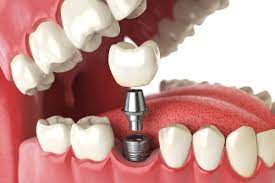Dental implants are artificial tooth roots that are used to support a replacement tooth or bridge. The implant itself is typically made of titanium and is surgically placed into the jawbone. The procedure for getting a dental implant can vary depending on the patient’s individual needs and circumstances. In this article, we will discuss what the dental implant procedure is like and how long it typically takes, as well as compare it to the dental bonding procedure.
Dental Implant Procedure
The first step in getting a dental implant is to consult with a dentist or oral surgeon who is experienced in implant dentistry. During this initial consultation, the dentist will examine your mouth and take X-rays to determine if you are a good candidate for dental implants. You will also discuss your treatment options and any concerns you may have.
If you are deemed a good candidate for dental implants, the next step is to prepare your mouth for the procedure. This may involve extracting any damaged or decayed teeth, as well as any necessary bone grafting procedures to ensure that your jawbone is strong enough to support the implant.
Once your mouth is prepared, the actual implant surgery can begin. The surgeon will make an incision in your gum tissue to expose the jawbone, and then drill a small hole into the bone where the implant will be placed. The implant is then screwed or pressed into place, and the gum tissue is sutured closed over the implant.
After the implant is placed, a healing process begins. The implant needs to fuse with the surrounding jawbone in a process called osseointegration. This can take several months, during which time you will wear a temporary crown or bridge to fill in the gap where your missing tooth or teeth used to be.
Once osseointegration is complete, the dentist will take an impression of your mouth to create a custom-made replacement tooth or bridge. This will be attached to the implant with an abutment, which is a small connector that screws onto the implant. The replacement tooth or bridge is then cemented or screwed into place on top of the abutment.
How Long Does The Dental Implant Procedure Take?
The dental implant procedure can take several months to complete, depending on a number of factors. The length of time it takes for the implant to fuse with the jawbone during osseointegration is the primary factor that determines the overall length of the procedure. Typically, this process takes between three and six months.
In addition to osseointegration, the length of the dental implant procedure can also be influenced by the patient’s overall health, the condition of their mouth, and any complications that may arise during the procedure.
Dental Bonding Procedure
Dental bonding is a cosmetic dental procedure that involves the application of a tooth-colored resin material to the surface of the teeth. The material is then hardened using a special light, and shaped and polished to match the surrounding teeth.
Unlike dental implants, dental bonding does not involve surgery or the placement of an artificial tooth root. Instead, it is used primarily for cosmetic purposes, such as repairing chipped or cracked teeth, filling in gaps between teeth, and improving the appearance of discolored teeth.
The dental bonding procedure is relatively quick and simple, taking between 30 minutes to an hour per tooth. However, it is important to note that dental bonding is not as durable or long-lasting as dental implants, and may need to be replaced or repaired more frequently.
Conclusion
In conclusion, the dental implant procedure involves the placement of an artificial tooth root into the jawbone, followed by a healing process and the attachment of a replacement tooth or bridge. This procedure can take several months to complete and requires surgery, but it is a durable and long-lasting solution for missing teeth. On the other hand, dental bonding is a cosmetic procedure that involves the application of a tooth-colored resin material to the surface of the teeth, and is primarily used for repairing minor cosmetic issues. While dental bonding is a quicker and simpler procedure, it is not as durable or long-lasting as dental implants. Ultimately, the choice between these two procedures will depend on your individual needs and circumstances, and should be made in consultation with your dentist or oral surgeon.

